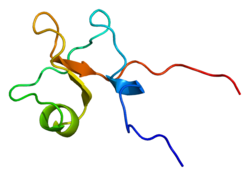Function
Members of the trefoil family are characterized by having at least one copy of the trefoil motif, a 40-amino acid domain that contains three conserved disulfide bonds. They are stable secretory proteins expressed in gastrointestinal mucosa. Their functions are diverse, including protection of the mucosa, thickening of the mucus, and increasing epithelial healing rates. This gene is a marker of columnar epithelium and is expressed in a variety of tissues including goblet cells of the intestines and colon. This gene and two other related trefoil family member genes are found in a cluster on chromosome 21. [7]
Glycan binding
All three human trefoil factors are lectins that interact specifically with the disaccharide GlcNAc-α-1,4-Gal. [8] This disaccharide is an unusual glycotope that is only known to exist on the large, heavily glycosylated, mucins in the mucosa. By cross-linking mucins through the bivalent binding of this glycotope, the trefoil factors are then able to reversible modulate the thickness and viscosity of the mucus. [8]
In breast milk
Trefoil factors (TFF) are secretory products of mucin producing cells. They play a key role in the maintenance of the surface integrity of oral mucosa and enhance healing of the gastrointestinal mucosa by a process called restitution. TFF comprises the gastric peptides (TFF1), spasmolytic peptide (TFF2), and the intestinal trefoil factor (TFF3, this protein). They have an important and necessary role in epithelial restitution within the gastrointestinal tract. Significant amounts of TFF are present in human milk. Evidence has been presented that TFF3 isolated from milk strongly correlates with downregulation of IL-6 and IL-8 in human intestinal epithelial cells. On the other hand, TFF3 activated the epithelial cells in culture to produce beta-defensin 2 (hBD2) and beta defensins 4 (hBD4). These findings suggest that TFF can activate intestinal epithelial cells and could actively participate in the immune system of breastfed babies by inducing the production of peptides related to innate defence, such as defensins. [9]
Activation of PAR-2 receptors
Two main mechanisms have been described for the activation of PAR-2: (A) by specific cleavage that unmask the receptor-activating peptide sequence present in the extracellular N-terminal domain of each PAR, leading to cell signaling via interaction of the exposed tethered ligand with the body of the receptor itself; and (B) by synthetic peptides, such as SLIGKV, that bind to the receptor, mimicking the actions of agonist proteases. [10] During lactation, TFF3 secreted in human milk may activate intestinal epithelial cells through PAR-2 receptors, which in turn induces hBD2 and hBD4 expression and cytokine regulation. [10]
This page is based on this
Wikipedia article Text is available under the
CC BY-SA 4.0 license; additional terms may apply.
Images, videos and audio are available under their respective licenses.







